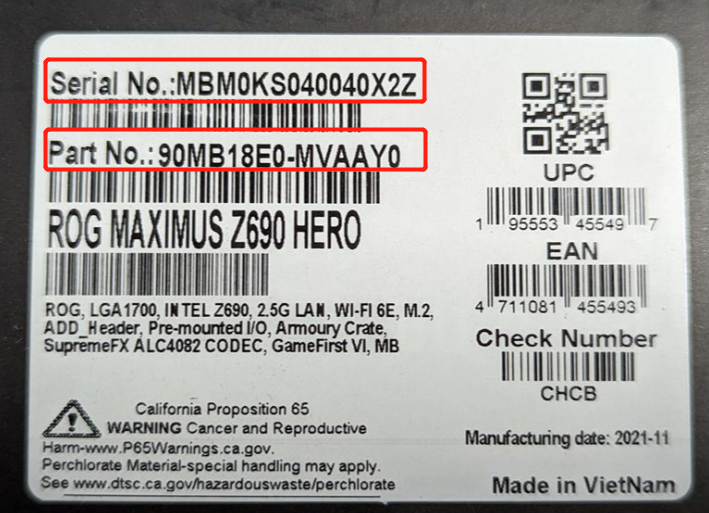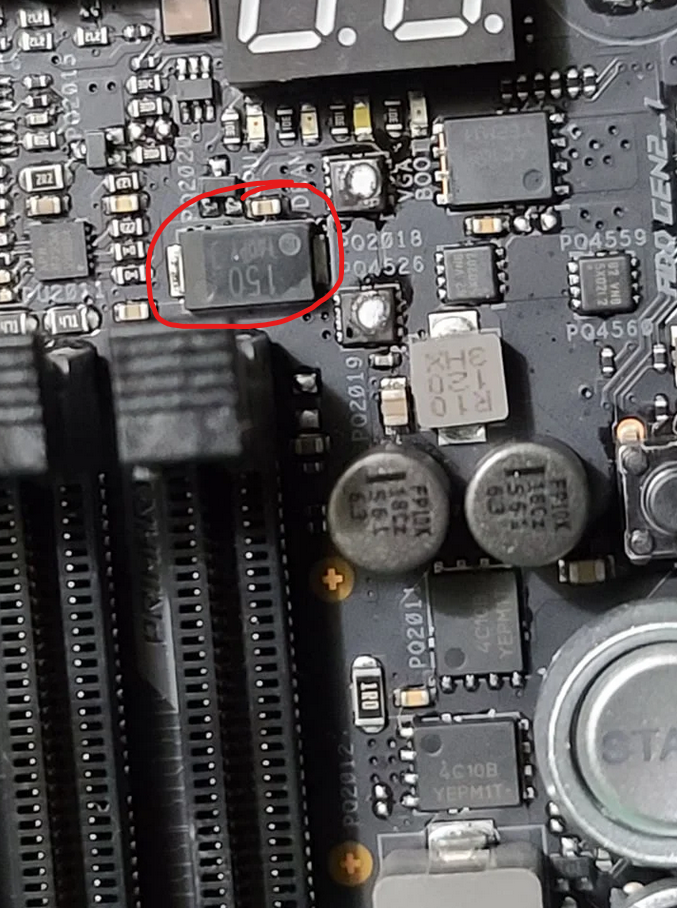Asus Admits Fiery Z690 Motherboard Flaw, Starts Recall Program (Updated)
We're not holding out for a (flaming) hero.
Update 12/30/2020: Asus has opened a new webpage that you can use to see if your motherboard is impacted by the failures. You can find the webpage here.
Original Report:
Last week widespread reports of melting MOSFETs on Asus' Z690 Hero motherboards emerged across various social media platforms, with pictures of motherboards that met a fiery fate spurring a bit of investigation from the enthusiast community. We followed up with Asus to learn more, and the company acknowledged the issues to Tom's Hardware and provided a full statement on the underlying causes (below). The company is also beginning a recall/replacement program for impacted users, but that will take some time to come into effect. If you have a Z690 Hero, be sure to read our outline below that tells you a few ways to determine if your board is impacted — if it is, you should stop using it right away.
Interestingly, YouTuber Buildzoid's theory of the root cause was correct (more on that after the statement). It all boils down to a capacitor that Asus inadvertently installed backward. Here's Asus' statement:
"To our valued ASUS Customers, ASUS is committed to producing the highest quality products and we take every incident report from our valued customers very seriously. We have recently received incident reports regarding the ROG Maximus Z690 Hero motherboard. In our ongoing investigation, we have preliminarily identified a potential reversed memory capacitor issue in the production process from one of the production lines that may cause debug error code 53, no post, or motherboard components damage. The issue potentially affects units manufactured in 2021 with the part number 90MB18E0-MVAAY0 and serial number starting with MA, MB, or MC.
You can identify your part number by referring to the product packaging:

As of December 28, 2021, there have been a few incidents reported in North America. Going forward, we are continuing our thorough inspection with our suppliers and customers to identify all possible affected ROG Maximus Z690 Hero motherboards in the market and will be working with relevant government agencies on a replacement program. Thank you so much to everyone for your patience and support while we are working through the replacement program.
If you have any questions or concerns please feel free to contact ASUS customer service. Best regards, The ASUS Team."
After widespread reports of the issue washed over various enthusiast forums and Reddit, YouTube Buildzoid performed his own analysis, which you can see in the video below.
In short, all of the impacted motherboards had one commonality: two burned-out MOSFETs that are responsible for providing 5V power to a number of components on the motherboard, including the power delivery subsystem for the DDR5 modules.
Get Tom's Hardware's best news and in-depth reviews, straight to your inbox.

Buildzoid correctly surmised that the issue didn't stem from the MOSFETs, but rather the capacitor right next to them. Comparing pictures of the impacted motherboards to fully-functioning boards reveals the capacitor is installed backward, thus reversing polarity and leading to the MOSFET failures.
If you own an Asus Z690 Hero and aren't aware of the batch number, you need to check the capacitor that you see circled in the image above (it is between the DIMM slots and Q-Code reader). If the "150" is aligned upside down, it is best to stop using the motherboard and contact Asus customer support.
It's encouraging to see Asus step up and acknowledge the issues quickly and take steps to begin a replacement program immediately. We're told that Asus is working with the Consumer Product Safety Commission (CSPC) to label the replacement program as an official recall, at which time users can begin the replacement process. We'll update you as more details become available.

Paul Alcorn is the Editor-in-Chief for Tom's Hardware US. He also writes news and reviews on CPUs, storage, and enterprise hardware.
-
ottonis So, I guess this is the kind of risk for early adopters of a new platform. There were also rumors about some DDR5 timing issues on the new Intel platform.Reply
For critical work, e.g. everything that demands high stability, (e.g. people working from home on their own machines and who need to update or replace an old system), one would certainly be be better off with something that has been in the market for at least 12 months - the usual time frame for CPU, RAM and Mobo makers to sort out all kind of hardware and driver glitches, make firmware updates and adapt their components to work with each other flawlessly.
If I was in the market for a new system, the Core i5 12600k would be my favourite CPU with a good motherboard - in theory. However, the new Intel platform is certainly not sufficiently real-word tested in order to be blindly trusted for critical work especially by those who are not willing or not able to tinker around with tons of firmware updates etc.
If I was earning money with creative work (e.g. video editing, some rendering), then I would rather opt for a trusted Ryzen-based system that's been out there for year or so. -
svan71 Inexcusable mistake from a "premium" board manufacturer. How did it pass QC and actually ship?Reply -
Co BIY ottonis beat me to the early adopter comment.Reply
I believe this is why HED usually lagged behind the consumer market. -
-Fran- Reply
This particular defect found on the board has absolutely nothing to do with "early adoption". This same problem could have happened to an X470, B550, or any other already "old" motherboard. It just happened to a new model.ottonis said:So, I guess this is the kind of risk for early adopters of a new platform. There were also rumors about some DDR5 timing issues on the new Intel platform.
For critical work, e.g. everything that demands high stability, (e.g. people working from home on their own machines and who need to update or replace an old system), one would certainly be be better off with something that has been in the market for at least 12 months - the usual time frame for CPU, RAM and Mobo makers to sort out all kind of hardware and driver glitches, make firmware updates and adapt their components to work with each other flawlessly.
If I was in the market for a new system, the Core i5 12600k would be my favourite CPU with a good motherboard - in theory. However, the new Intel platform is certainly not sufficiently real-word tested in order to be blindly trusted for critical work especially by those who are not willing or not able to tinker around with tons of firmware updates etc.
If I was earning money with creative work (e.g. video editing, some rendering), then I would rather opt for a trusted Ryzen-based system that's been out there for year or so.
Batches with bad components or very specific defects happen in all industries and it's just related to bad QC.
Regards. -
Why_Me Reply
I take it you didn't read the article. This has nothing to do with Intel and all to do with Asus quality control.ottonis said:So, I guess this is the kind of risk for early adopters of a new platform. There were also rumors about some DDR5 timing issues on the new Intel platform.
For critical work, e.g. everything that demands high stability, (e.g. people working from home on their own machines and who need to update or replace an old system), one would certainly be be better off with something that has been in the market for at least 12 months - the usual time frame for CPU, RAM and Mobo makers to sort out all kind of hardware and driver glitches, make firmware updates and adapt their components to work with each other flawlessly.
If I was in the market for a new system, the Core i5 12600k would be my favourite CPU with a good motherboard - in theory. However, the new Intel platform is certainly not sufficiently real-word tested in order to be blindly trusted for critical work especially by those who are not willing or not able to tinker around with tons of firmware updates etc.
If I was earning money with creative work (e.g. video editing, some rendering), then I would rather opt for a trusted Ryzen-based system that's been out there for year or so. -
ottonis ReplyWhy_Me said:I take it you didn't read the article. This has nothing to do with Intel and all to do with Asus quality control.
And yet this kind of problems is mostly found at production start of a new platform or new model, where existing QC SOPs have not yet been fully adopted to the new parts and processes.
We are not talking about generally good or bad QC with the occasional between-item variations in quality and montage precision but about gross variations of QC over time during the course of a generational iteration.
Usually, at the beginning of a new (model/platform) generation there are more errors and mistakes than later. This entirely normal.
And yes, this Asus mobo is a new model and belongs to a new generation and completely new platform. -
Why_Me Reply
It was bad QC on Asus part. Nothing more and nothing less.ottonis said:And yet this kind of problems is mostly found at production start of a new platform or new model, where existing QC SOPs have not yet been fully adopted to the new parts and processes.
We are not talking about generally good or bad QC with the occasional between-item variations in quality and montage precision but about gross variations of QC over time during the course of a generational iteration.
Usually, at the beginning of a new (model/platform) generation there are more errors and mistakes than later. This entirely normal.
And yes, this Asus mobo is a new model and belongs to a new generation and completely new platform. -
hasten Reply
On a product they have been producing for decades. And because of a quite obvious engineering flaw. I would love some evidence to back up the "usually" and "mostly found" claims. Being an early adopter for over 20 years I've yet to run into soldering a component on reverse or anything close to such a egregious QC oversight which leads me to believe this doesn't "usually" happen.ottonis said:And yet this kind of problems is mostly found at production start of a new platform or new model, where existing QC SOPs have not yet been fully adopted to the new parts and processes.
We are not talking about generally good or bad QC with the occasional between-item variations in quality and montage precision but about gross variations of QC over time during the course of a generational iteration.
Usually, at the beginning of a new (model/platform) generation there are more errors and mistakes than later. This entirely normal.
And yes, this Asus mobo is a new model and belongs to a new generation and completely new platform.
As stated by the individual above, this is a QC disaster nothing more nothing less. They green lit production with a component on reverse.
